Page 1462 of 3342
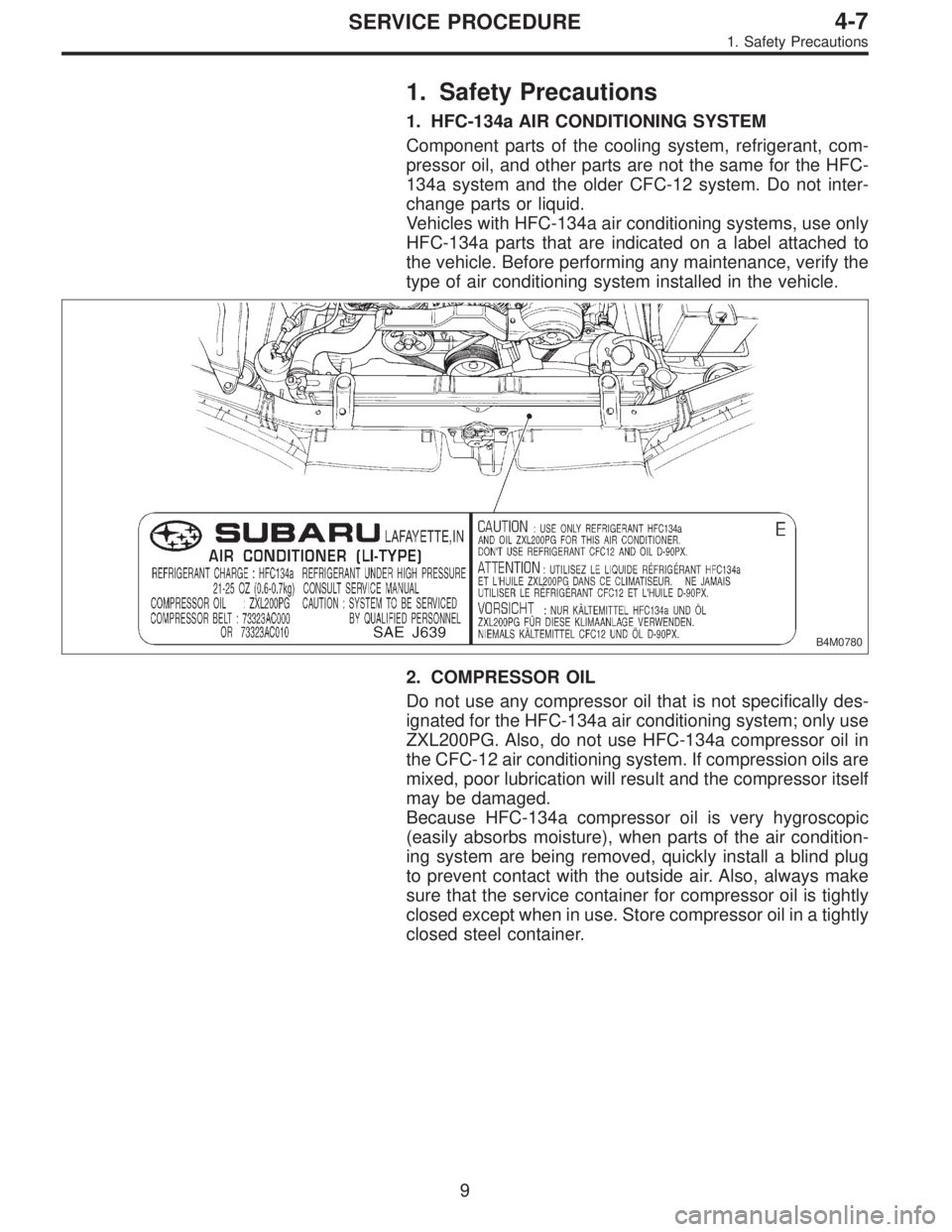
1. Safety Precautions
1. HFC-134a AIR CONDITIONING SYSTEM
Component parts of the cooling system, refrigerant, com-
pressor oil, and other parts are not the same for the HFC-
134a system and the older CFC-12 system. Do not inter-
change parts or liquid.
Vehicles with HFC-134a air conditioning systems, use only
HFC-134a parts that are indicated on a label attached to
the vehicle. Before performing any maintenance, verify the
type of air conditioning system installed in the vehicle.
B4M0780
2. COMPRESSOR OIL
Do not use any compressor oil that is not specifically des-
ignated for the HFC-134a air conditioning system; only use
ZXL200PG. Also, do not use HFC-134a compressor oil in
the CFC-12 air conditioning system. If compression oils are
mixed, poor lubrication will result and the compressor itself
may be damaged.
Because HFC-134a compressor oil is very hygroscopic
(easily absorbs moisture), when parts of the air condition-
ing system are being removed, quickly install a blind plug
to prevent contact with the outside air. Also, always make
sure that the service container for compressor oil is tightly
closed except when in use. Store compressor oil in a tightly
closed steel container.
9
4-7SERVICE PROCEDURE
1. Safety Precautions
Page 1463 of 3342

3. REFRIGERANT
Do not put CFC-12 refrigerant into a HFC-134a air condi-
tioning system. Also, do not put HFC-134a refrigerant into
a CFC-12 air conditioning system. If the wrong refrigerant
is used, poor lubrication will result and the compressor
itself may be destroyed.
G4M0979
4. HANDLING OF REFRIGERANT
Because refrigerant boils at approx. �30°C (�22°F) at sea
level, it is cold enough to give you severe frostbite. Always
wear goggles to protect your eyes and gloves to protect
your hands. Also, even under the pressures normally found
in CFC-12 containers, refrigerant will boil with the addition
of heat. This could raise the pressure inside the container
to a dangerous level.
Never expose a can of HFC-134a to direct sunlight, or to
temperatures over 40°C (104°F). One more thing to
remember about HFC-134a is that when it is exposed to an
open flame or to hot metal, it forms phosgene, a deadly
gas. Do not discharge HFC-134a into the atmosphere on
purpose. Always read and follow the precautions on the
HFC-134a bottle.
10
4-7SERVICE PROCEDURE
1. Safety Precautions
Page 1464 of 3342
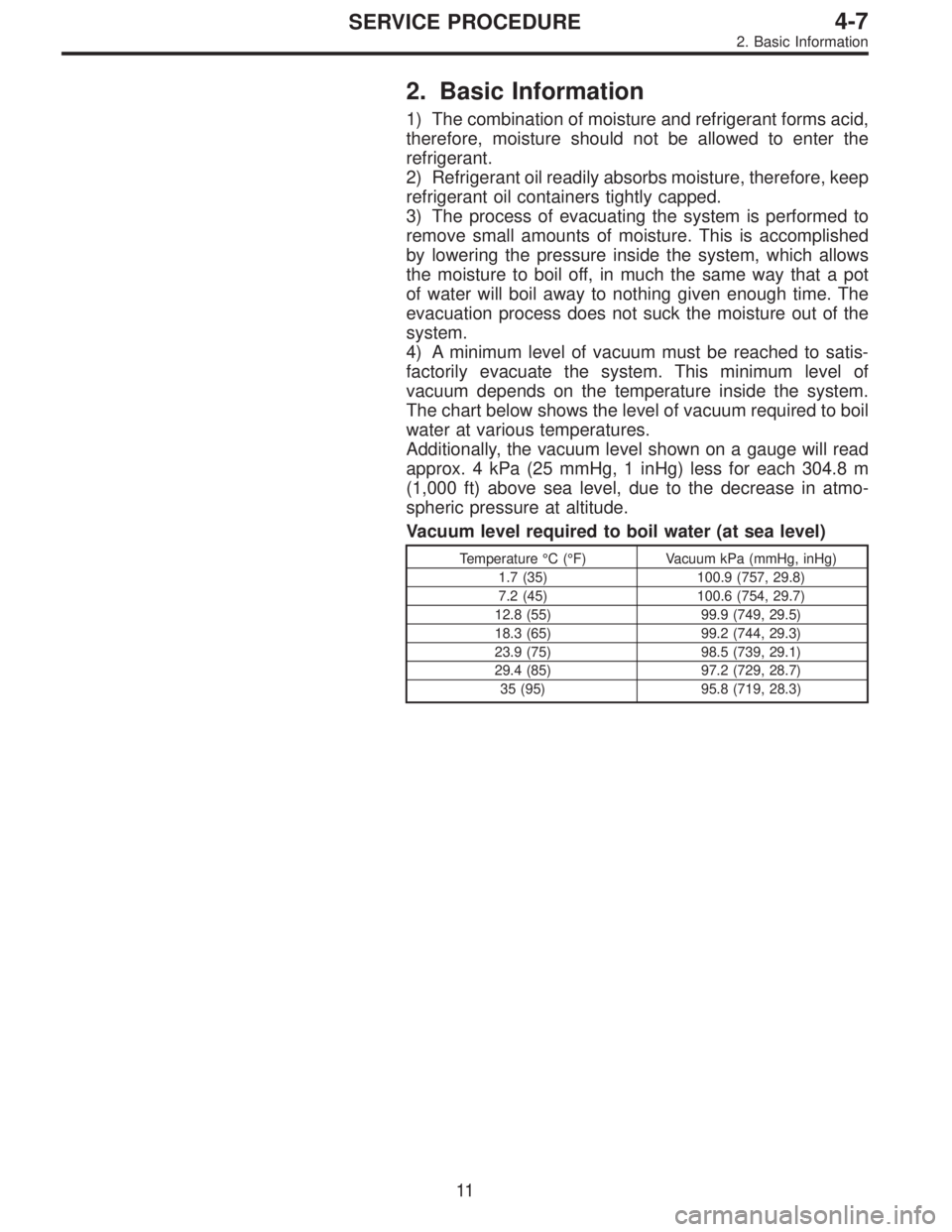
2. Basic Information
1) The combination of moisture and refrigerant forms acid,
therefore, moisture should not be allowed to enter the
refrigerant.
2) Refrigerant oil readily absorbs moisture, therefore, keep
refrigerant oil containers tightly capped.
3) The process of evacuating the system is performed to
remove small amounts of moisture. This is accomplished
by lowering the pressure inside the system, which allows
the moisture to boil off, in much the same way that a pot
of water will boil away to nothing given enough time. The
evacuation process does not suck the moisture out of the
system.
4) A minimum level of vacuum must be reached to satis-
factorily evacuate the system. This minimum level of
vacuum depends on the temperature inside the system.
The chart below shows the level of vacuum required to boil
water at various temperatures.
Additionally, the vacuum level shown on a gauge will read
approx. 4 kPa (25 mmHg, 1 inHg) less for each 304.8 m
(1,000 ft) above sea level, due to the decrease in atmo-
spheric pressure at altitude.
Vacuum level required to boil water (at sea level)
Temperature°C(°F) Vacuum kPa (mmHg, inHg)
1.7 (35) 100.9 (757, 29.8)
7.2 (45) 100.6 (754, 29.7)
12.8 (55) 99.9 (749, 29.5)
18.3 (65) 99.2 (744, 29.3)
23.9 (75) 98.5 (739, 29.1)
29.4 (85) 97.2 (729, 28.7)
35 (95) 95.8 (719, 28.3)
11
4-7SERVICE PROCEDURE
2. Basic Information
Page 1465 of 3342
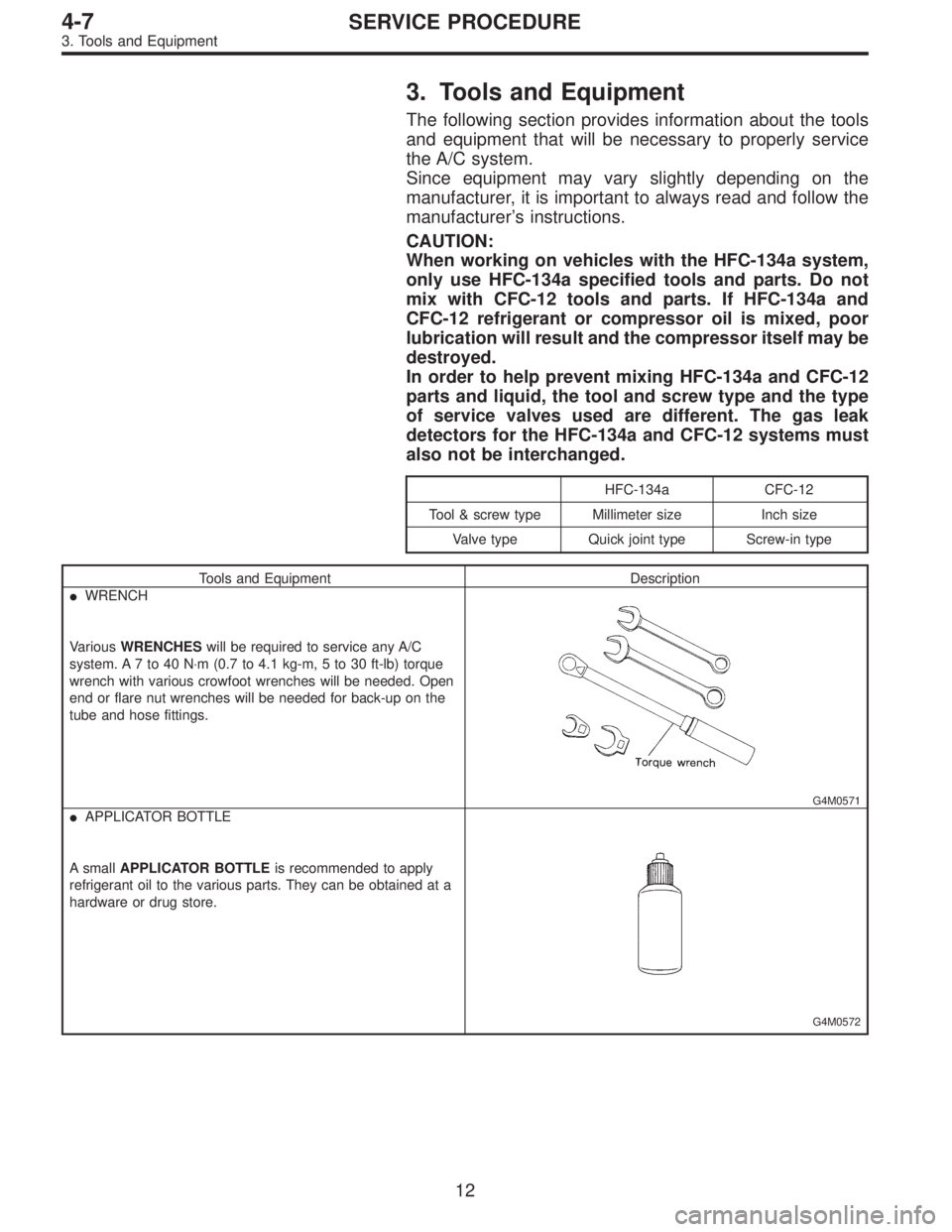
3. Tools and Equipment
The following section provides information about the tools
and equipment that will be necessary to properly service
the A/C system.
Since equipment may vary slightly depending on the
manufacturer, it is important to always read and follow the
manufacturer’s instructions.
CAUTION:
When working on vehicles with the HFC-134a system,
only use HFC-134a specified tools and parts. Do not
mix with CFC-12 tools and parts. If HFC-134a and
CFC-12 refrigerant or compressor oil is mixed, poor
lubrication will result and the compressor itself may be
destroyed.
In order to help prevent mixing HFC-134a and CFC-12
parts and liquid, the tool and screw type and the type
of service valves used are different. The gas leak
detectors for the HFC-134a and CFC-12 systems must
also not be interchanged.
HFC-134a CFC-12
Tool & screw type Millimeter size Inch size
Valve type Quick joint type Screw-in type
Tools and Equipment Description
�WRENCH
VariousWRENCHESwill be required to service any A/C
system. A 7 to 40 N⋅m (0.7 to 4.1 kg-m, 5 to 30 ft-lb) torque
wrench with various crowfoot wrenches will be needed. Open
end or flare nut wrenches will be needed for back-up on the
tube and hose fittings.
G4M0571
�APPLICATOR BOTTLE
A smallAPPLICATOR BOTTLEis recommended to apply
refrigerant oil to the various parts. They can be obtained at a
hardware or drug store.
G4M0572
12
4-7SERVICE PROCEDURE
3. Tools and Equipment
Page 1466 of 3342
Tools and Equipment Description
�MANIFOLD GAUGE SET
AMANIFOLD GAUGE SET(with hoses) can be obtained
from either a commercial refrigeration supply house or from
an auto shop equipment supplier.
G4M0573
�REFRIGERANT RECOVERY SYSTEM
AREFRIGERANT RECOVERY SYSTEMis used for the
recovery and reuse of A/C system refrigerant after
contaminants and moisture have been removed from the
refrigerant.
G4M0574
�SYRINGE
A graduated plasticSYRINGEwill be needed to add oil back
into the system. The syringe can be found at a pharmacy or
drug store.
G4M0575
�VACUUM PUMP
AVACUUM PUMP(in good working condition) is necessary,
and may be obtained from either a commercial refrigeration
supply house or an automotive equipment supplier.
G4M0576
�CAN TAP
ACAN TAPfor the 397 g (14 oz) can is available from an
auto supply store.
G4M0577
13
4-7SERVICE PROCEDURE
3. Tools and Equipment
Page 1467 of 3342
Tools and Equipment Description
�THERMOMETER
PocketTHERMOMETERSare available from either industrial
hardware store or commercial refrigeration supply houses.
G4M0578
�ELECTRONIC LEAK DETECTOR
AnELECTRONIC LEAK DETECTORcan be obtained from
either a specialty tool supply or an A/C equipment supplier.
G4M0579
�WEIGHT SCALE
AWEIGHT SCALEsuch as an electronic charging scale or a
bathroom scale with digital display will be needed if a 13.6 kg
(30 lb) refrigerant container is used.
G4M0580
14
4-7SERVICE PROCEDURE
3. Tools and Equipment
Page 1468 of 3342
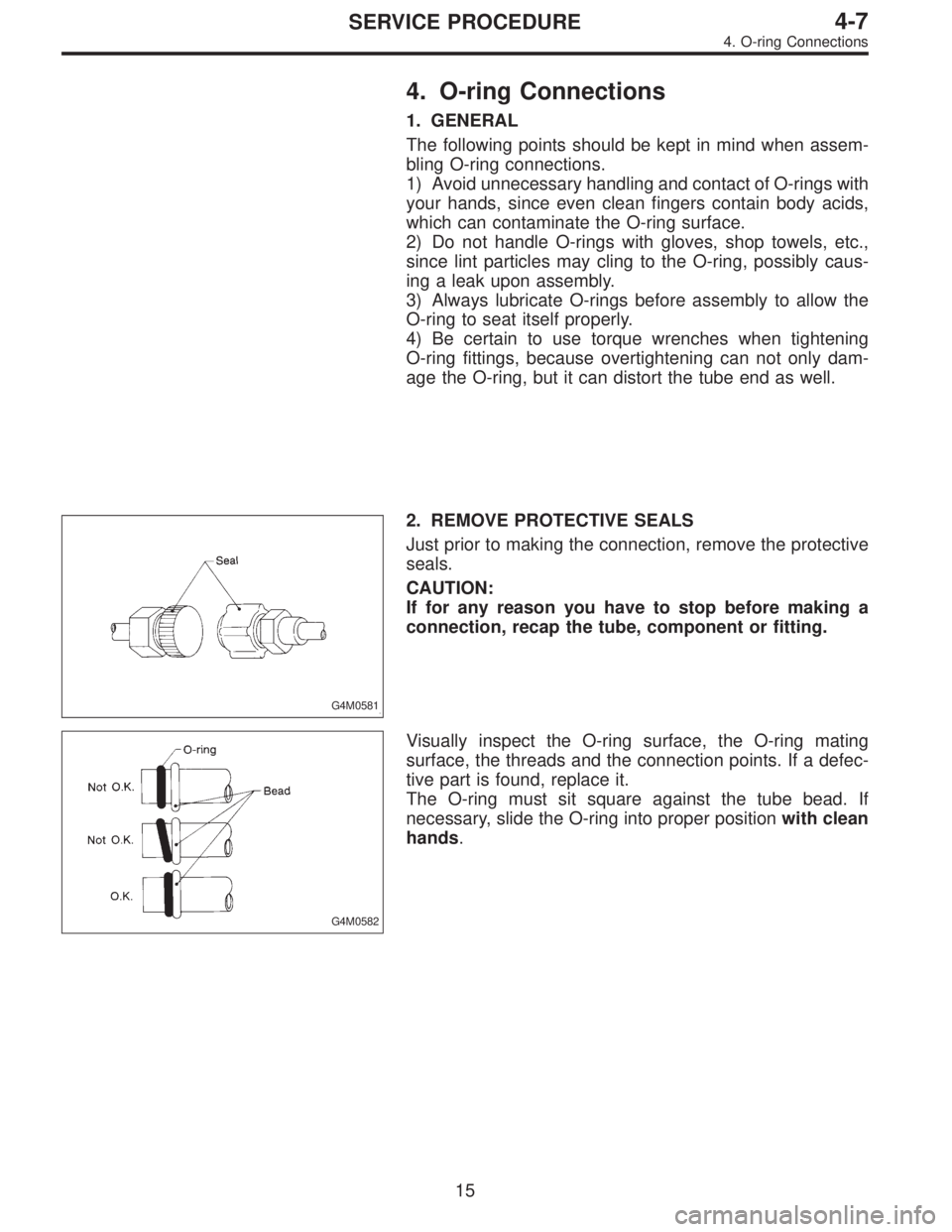
4. O-ring Connections
1. GENERAL
The following points should be kept in mind when assem-
bling O-ring connections.
1) Avoid unnecessary handling and contact of O-rings with
your hands, since even clean fingers contain body acids,
which can contaminate the O-ring surface.
2) Do not handle O-rings with gloves, shop towels, etc.,
since lint particles may cling to the O-ring, possibly caus-
ing a leak upon assembly.
3) Always lubricate O-rings before assembly to allow the
O-ring to seat itself properly.
4) Be certain to use torque wrenches when tightening
O-ring fittings, because overtightening can not only dam-
age the O-ring, but it can distort the tube end as well.
G4M0581
2. REMOVE PROTECTIVE SEALS
Just prior to making the connection, remove the protective
seals.
CAUTION:
If for any reason you have to stop before making a
connection, recap the tube, component or fitting.
G4M0582
Visually inspect the O-ring surface, the O-ring mating
surface, the threads and the connection points. If a defec-
tive part is found, replace it.
The O-ring must sit square against the tube bead. If
necessary, slide the O-ring into proper positionwith clean
hands.
15
4-7SERVICE PROCEDURE
4. O-ring Connections
Page 1469 of 3342
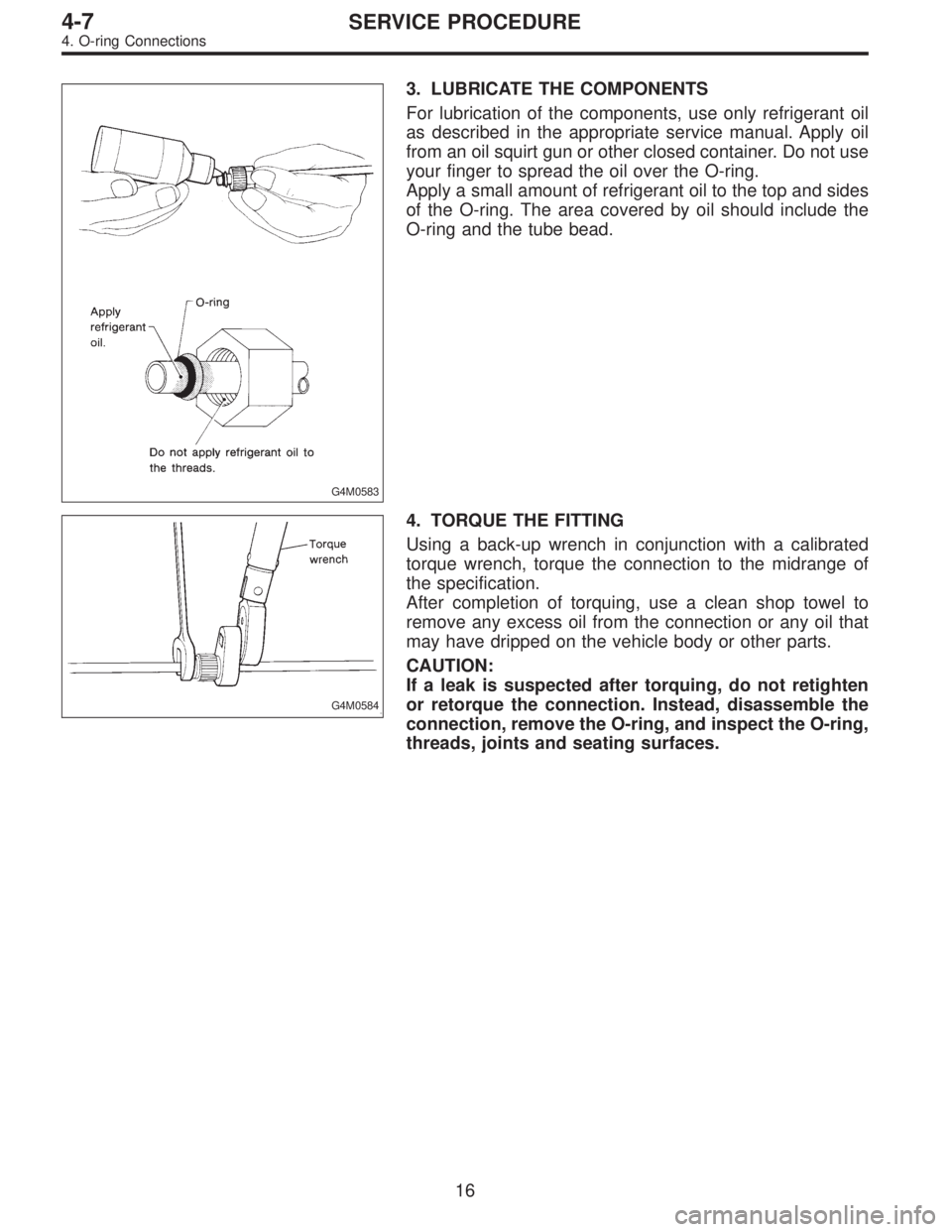
G4M0583
3. LUBRICATE THE COMPONENTS
For lubrication of the components, use only refrigerant oil
as described in the appropriate service manual. Apply oil
from an oil squirt gun or other closed container. Do not use
your finger to spread the oil over the O-ring.
Apply a small amount of refrigerant oil to the top and sides
of the O-ring. The area covered by oil should include the
O-ring and the tube bead.
G4M0584
4. TORQUE THE FITTING
Using a back-up wrench in conjunction with a calibrated
torque wrench, torque the connection to the midrange of
the specification.
After completion of torquing, use a clean shop towel to
remove any excess oil from the connection or any oil that
may have dripped on the vehicle body or other parts.
CAUTION:
If a leak is suspected after torquing, do not retighten
or retorque the connection. Instead, disassemble the
connection, remove the O-ring, and inspect the O-ring,
threads, joints and seating surfaces.
16
4-7SERVICE PROCEDURE
4. O-ring Connections